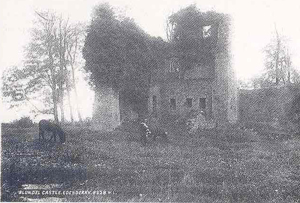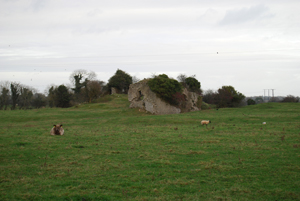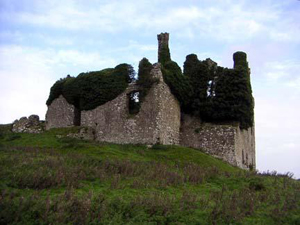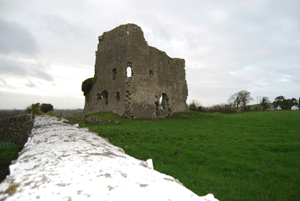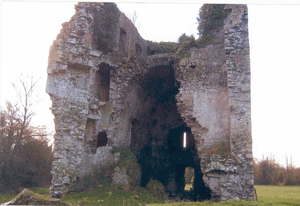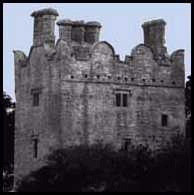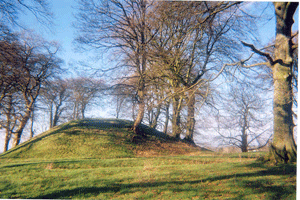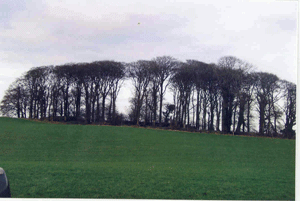

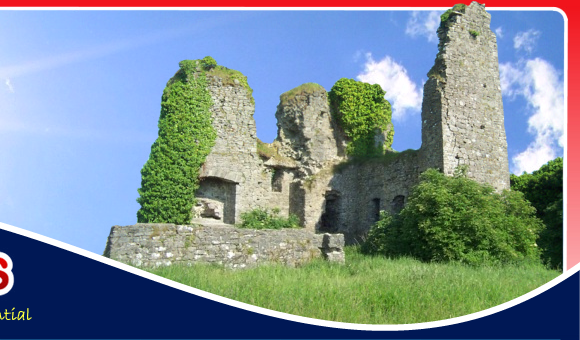

CASTLES AND RUINS
The town of Edenderry is surrounded by a series of hills; Blundell Hill, Ballykilleen Hill, Drumcooley Hill, Carrick Hill and Carbury Hill. On those hills one finds evidence of prehistoric forts, motte and baileys and many prominent and majestic castles:
Blundell Castle: By Jordan (4th Class) Blundell Castle was built in the 15th century.
It was originally built by the De Bermingham familywho also built other castles in the Edenderry area. In the middle of the 16th century a family lived there called Colley.Edenderry was know as Coolestown or Colleytown. Stone and rocks were used to build the castle. Sir George Colley defended the castle from attack by the O'Neill forces in 1599 during the Nine Years War.
In May of 1691 the army of JamesII attacked the castle and it has been derelict ever since. The castle today is a tourist spot and people take photos of it. It is also the site of a water tower which supplies the town of Edenderry with water.
Monasteroris Friary: by Patrick (4th Class)
Monasteroris Friary is about 4kms west of Edenderry. Most of the church, today, is overgrownwith ivy. The name of the friary, Monasteroris comes from the Irish version of the name, mainistir Mhic Fheorais, the monastery of the son of Feorais. Feorais is the Gaelicised version of Pierce the father of the founder, John de Bermingham, the Earl of Louth who brought the friars there in 1325. It is thought that he built this friary to quell his conscience over the massacre of 32 local chieftains by his father in Carrick Castle twenty years previously.
Carbury Castle: by Patrick (4th Class) Carbury Castle is located east of the Bog of Allen in County Kildare.It situated high on top of a hilljust beyond the present day Church of Ireland and is in the village of Carbury.It is spelled a couple of different ways like ‘Carbery and Carberry'but the village sign and the present day church both read ‘Carbury'.The Motte was made by Meiler Fitzhenry who was given the area by Strongbow.It was acquired in the 14 th century by the de Berminghams (who also built Carrick and probably Blundell Castles). The older parts of the castle were probably built by them. In the 15 th century, the castle was given to the native Irish and in 1562 it was granted to the Colley family, the ancestors of the Duke of Wellington. They built a large stronghouse there in the 17th century. The castle today is in ruins and overgrown with ivy .
Carrick Castle & Church -By Patrick, Óran, Richie, Christian and Seán The Parish Church of Carrick is not that well known. It dates back to at least 13th century. It is about 60 feet long by 25 broad .Two window gothic but of different time periods are positioned at the south of the church .
They seemed to be at the North wall . The ruins of the Carrick church stands in a burial ground in which Rev. Andrew Duggan who died of fever in Carlow in 1837 he now lies in rest with his relatives.
Adjoining the church is the ruins of Carrick Castle .It was ‘originally a tall square tower .It must have been at least 90 feet long the walls were 4 feet thick 32 feet in length it was built by Sir Pierce Bermingham. One year of the O Connors kids was having his Confirmation .The O Connor’s and the Berminghams had been fighting for years. They decided to have peace so the O Connor’s decided to ask the Berminghams to sponsor 12 year old Calbach O’ Connor. After the Comfirmation they had a party while the party was going on Calbach O’ Connor was thrown off the top of the battlements.
Later that year the Berminghams invited the O’ Connors to Christmas dinner to make up for the 12 year olds death. During the dinner the soldiers guarded the doors and all 28 of the O’ Connors were beheaded and sent to Dublin for ten pounds per head. After a few years Sir Pierce De Bermingham realised what he had done wrong so he built a Monastery for the remaining O’ Connors. This monastery is known as Monasteroris.
Kinnefad Castle By Eoin, Graham, Peter, Conor, Marc and Brendan Kinnefad castle is in the parish of Balyna in co. Kildare. At Kinnefad (Ceann – Átha Fada ‘the head of the ford) is a stronghold, in ruins, of the Birmingham family.
Kinnefad is a large square block of building measuring 15 m by 12m on the outside; the external walls are quite perfect. It has a few narrow windows where strength was more important than comfort.
Kinnefad castle stands on the banks of the River Boyne, about 5 km from Edenderry. Local traditions say it was often the site of fierce battles. Lord Downshire’s agent had in his possessions several antique weapons dug up at Kinnefad. These are sword blades, spearheads etc. These have been donated to Cambridge University. About half a mile up the road lies Grange castle.
The remaining buildings and grounds were handed down to Hugh Tyrrell, who lives in England and from whom they are leased by The Tyrrell Trust Ltd.
Grange Castle By Ronan, Robert, Callum and Kevin Grange castle, which is a late 15th century (1460) tower house, was built by the Bermingham family-settlers from Norman England. The tower was embellished with ornate Jacobean chimneys and battlements in the early 17th century.
During 1735,the then owner, Walter Bermingham, Sold Grange to Thomas Tyrrell, in whose family it remained until in 1988 The late Bobby Tyrrell transferred ownership of the tower alone Dúchas (then the Office of Public Works).
From 1460 onwards, successive generations have added to or changed the character of Grange with the building of a great hall, now fully restored and named as the Fallon Hall; a walled garden, fully restored; a cow byre and various stables and courtyards which have yet to be restored.
Triple Ring Fort - Ballykilleen Hill - by Andrew, Damien, Aaron, Ricky & Lee The Ballykilleen Hill triple ringed fort is the oldest evidence of life in the Edenderry area dating back to approx 400 BC, around the time of the Iron Age Ballykilleen Hill [110 metres above sea level] is about 8 Km from the town of Edenderry.
In the 5th Century Kings of Ua bhFáilí, Ros Fhailge, lived here. The triple banked construction shows that it was built by people of importance and had both a military and strategic value.
It was fortress from where they could see all over the Midlands. At the foot of Ballykilleen Hill was a toll bridge and people had to pay to use the ancient road across the Bog of Allen, probably connecting Kildare to Tara This road was called a “Tóchar”, a pathway. There is a myth that there is an under-ground tunnel linking Ballykilleen to Drumcooley and Blundell castle. There are many stories told that there is gold stashed in this tunnel. Ghost stories are also linked to it. All that remains today are the embankments and a concrete plinth used by the Ordnance Survey to take levels.






